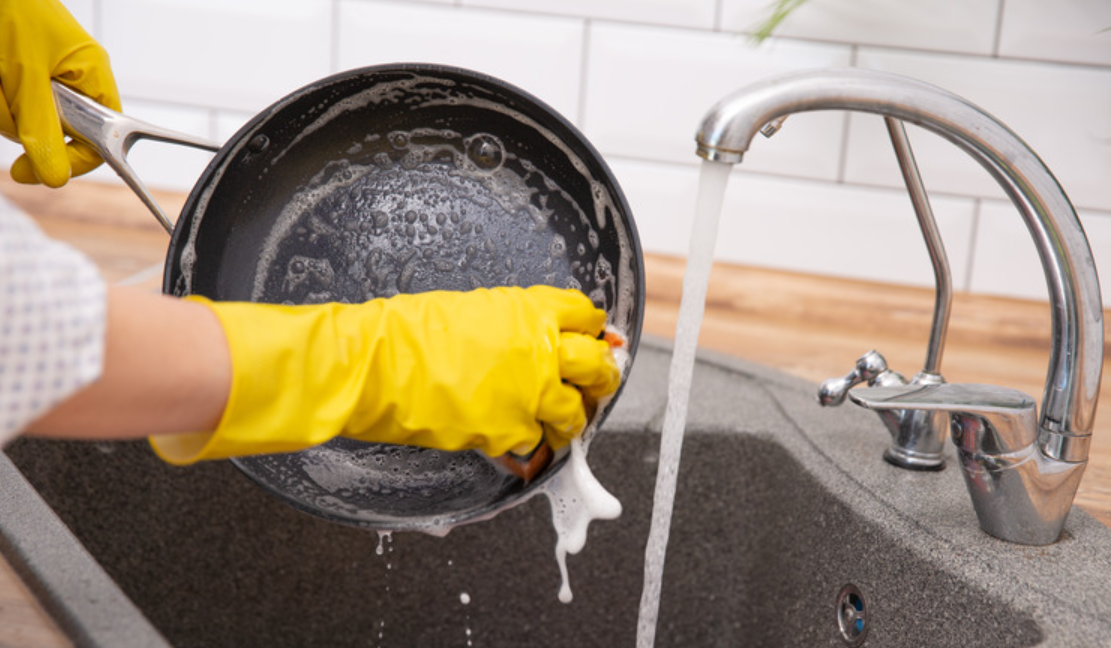Social Dude
Ceramic Pan Cleaning Tips
The Essentials for Ceramic Pan Cleaning
Before delving into cleaning details, let's gather the necessary supplies.
Warm soapy water
A mild dish soap mixed with warm water is the cornerstone of ceramic pan cleaning.
Baking soda
This kitchen staple proves to be a versatile cleaning agent.
White vinegar
It can help tackle stubborn stains and burnt-on residues.
Soft sponge or cloth
Opt for non-abrasive tools to avoid scratching the ceramic surface.
Nylon or silicone brush
It is useful for dislodging food particles without harming the ceramic coating.
Paper towels or a lint-free cloth
For drying and polishing your pan.
Cooking oil
A small amount of cooking oil can help maintain the pan's non-stick properties.
Homemade Ceramic Pan Cleaner Recipe
If you prefer making your cleaning solution, here's a simple recipe.
Ingredients
· 2 tablespoons baking soda
· 1 tablespoon white vinegar
· 1 tablespoon water
Instructions
· Mix the baking soda, white vinegar, and water to create a paste.
· Apply the paste to the stained or soiled areas of your pan.
· Allow it to sit for 15-20 minutes.
· Gently scrub with a soft sponge.
· Rinse and dry the pan thoroughly.
Ceramic Pan Cleaning Tips
1. Routine Cleaning
For everyday cleaning of your ceramic pan, follow these steps.
· Allow the pan to cool down after cooking.
· Wash it with warm, soapy water and a soft sponge or cloth.
· Rinse thoroughly to remove any soap residue.
· Dry the pan with a paper towel or lint-free cloth.
· Store it properly to prevent scratches, ideally using pan protectors or soft cloth between pans.
2. Removing Burnt-On Food
Sometimes, despite your best efforts, food can stick to the ceramic surface and become stubborn residues.
· Fill the pan with warm water and a few tablespoons of baking soda.
· Let it sit for an hour or longer, allowing the baking soda to soften the burnt-on food.
· After soaking, scrub gently with a nylon or silicone brush.
· Rinse thoroughly and dry the pan.
3. Stains and Discoloration
Stains and discolouration can result from cooking certain ingredients or overheating.
· Create a paste by mixing baking soda with a small amount of water.
· Apply the paste to the stained area and let it sit for 15-20 minutes.
· Gently scrub the stained area with a soft sponge.
· Rinse and dry the pan to reveal a stain-free surface.
4. Tackling Stubborn Residues
For those times when burnt-on residues seem impossible to remove, vinegar can be a savior.
· Pour a mixture of equal parts white vinegar and water into the pan.
· Place it on low heat and let it simmer for 15-20 minutes. The vinegar's acidity will help dissolve stubborn residues.
· Allow the pan to cool down, then scrub away the loosened residues with a nylon or silicone brush.
· Rinse and dry the pan.
5. Restoring Shine and Polish
Over time, your ceramic pan might lose its sheen. To restore that like-new luster.
· Make a paste by mixing equal parts baking soda and water.
· Apply the paste to the entire pan, inside and out.
· Gently scrub the surface with a soft sponge, paying extra attention to stained or discolored areas.
· Rinse the pan and dry it, leaving it looking shiny and refreshed.
6. Maintaining the Non-Stick Surface
Ceramic pans are cherished for their non-stick properties.
· After cleaning, rub a small amount of cooking oil onto the ceramic surface with a paper towel.
· Heat the pan on low for a minute to let the oil penetrate the ceramic coating.
· Wipe away any excess oil with a paper towel, leaving a thin, protective layer.
· Always avoid cooking sprays with fuels, as they can leave residues that degrade the non-stick quality.
What Not to Do
To keep your ceramic pans in top shape, avoid these things.
· Do not use metal scrubbers or abrasive scouring pads, as they can scratch the ceramic surface.
· Excessively high temperatures can damage the non-stick coating, so cook on medium or low heat.
· Cooking sprays can leave residues that degrade the non-stick quality.
· Most ceramic pans are not dishwasher safe, so hand washing is recommended.
Final words
Ceramic pans are a fantastic addition to any kitchen, but proper cleaning and maintenance are essential to ensure they remain in excellent condition. With the right tools and the DIY solutions mentioned in this guide, you can keep your ceramic pans spotless, non-stick, and ready to enhance your culinary adventures. A little care and attention will go a long way in preserving these kitchen treasures for years.


Comments